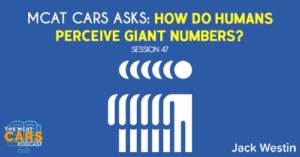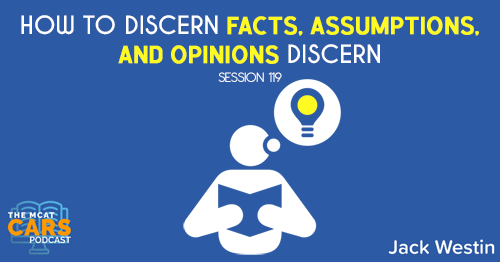Apple Podcasts | Google Podcasts

Session 47
Today’s MCAT CARS passage uses the idea of overpopulation to kick off a discussion about how humans perceive orders of magnitude.
Jack Westin joins us once again as we dig deep into today’s passage. If you’re looking for some more MCAT CARS prep, check out their free resources and Jack’s in-depth course that will help you improve your CARS score.
Listen to this podcast episode with the player above, or keep reading for the highlights and takeaway points.
Link to article:
https://getpocket.com/explore/item/how-to-understand-extreme-numbers
The late statistics wizard Hans Rosling, who died in February of 2017 at age 68, brought at least 10 toilet paper rolls to some of his beloved presentations. He would stack them into a tower on a table, each roll representing one billion people. In a 2012 talk at the Skoll World Forum, he used the rolls to show how, as the number of children in the world—2 billion—holds steady, the global population will rise from 7 billion to the (also indefinitely stable) figure of about 10 billion. “We are debating peak oil,” he remarked, “but we know that we have reached peak child.”
With his whimsical props and other colorful visualizations, Rosling was renowned as a translator between large, almost unfathomable numbers and the language of everyday experience. He understood that most of us need visualizations or analogies to mentally work with millions, billions, and other big powers of 10 that help define our world. They’re important for decisions that affect daily life, such as how money gets invested and which government policies you support. But just how well—or poorly—do people understand quantities in powers of 10? And how can we better equip ourselves to navigate them?
In thinking about these questions, I started reading about a niche branch of science called numerical cognition. Researchers in this field study not just how we think, but how we think about, and with, numbers.
Not a lot of research has been done on how our minds perceive and comprehend large orders of magnitude—big differences between the size of, say, a cell and our sun. But one academic outwardly passionate about it is David Landy, assistant professor of psychological and brain sciences at Indiana University in Bloomington. Landy has done several studies on how well people understand very large numbers—namely, the millions, billions, and trillions—in relation to each other on a number line.
“To me, the impressive thing is that people succeed at all.”
Short answer: About half the people he studied were pretty bad with handling big numbers. In a 2013 study, for example, Landy and colleagues did two experiments that involved estimating large numbers. The sample sizes weren’t huge, so there’s some uncertainty about generalizing the results, but they’re a start. They found that about half of participants did pretty well in locating numbers on a line in relation to 1 million, 1 billion, etc. But about 35 percent of people in the study used what the authors call a “segmented linear heuristic.” That means they correctly distinguish between numbers within the millions or billions, but assume that “million,” “billion,” and “trillion” are equally spaced on a number line. They were generally great at comparing the relative sizes of numbers like 2 million and 800 million, but many treated 980 million and 2 billion as nearly identical.
[02:10] What If You Disagree with What the Author Says?
The best way to improve your ability to understand these passages is to be willing to accept anything that comes your way.
'Don't take it personally.'Click To TweetIt can be hard especially when you’re able to connect or don’t connect with the author. But when answering these questions, you just have to go with whatever the author says.
[03:11] Paragraph 1, Sentence 1
The late statistics wizard Hans Rosling, who died in February of 2017 at age 68, brought at least 10 toilet paper rolls to some of his beloved presentations.
Jack says:
This is an interesting first sentence. But then again even if you don’t like the first sentence, you should still try to find interest in whatever you’re reading. Of course, if you find something intriguing, you will find it easier to read. So here, just imagine a math professor bringing toilet paper rolls.
[04:12] Paragraph 1, Sentence 2
He would stack them into a tower on a table, each roll representing one billion people.
Jack says:
Now, you know what they’re being used for.
[04:20] Paragraph 1, Sentence 3
In a 2012 talk at the Skoll World Forum, he used the rolls to show how, as the number of children in the world—2 billion—holds steady, the global population will rise from 7 billion to the (also indefinitely stable) figure of about 10 billion.
Jack says:
It just shows the representation of the population through the use of the toilet paper rolls.
[04:55] Paragraph 1, Sentence 4
“We are debating peak oil,” he remarked, “but we know that we have reached peak child.”
Jack says:
Most people usually think about peak oil like we’re going to run out of oil. And Rosling is saying that we should be talking about how there’s overpopulation.
[05:48] Paragraph 2, Sentence 1
With his whimsical props and other colorful visualizations, Rosling was renowned as a translator between large, almost unfathomable numbers and the language of everyday experience.
Jack says:
The author is suggesting that Rosling is a good communicator as he makes things easy to understand.
[06:12] Paragraph 2, Sentence 2
He understood that most of us need visualizations or analogies to mentally work with millions, billions, and other big powers of 10 that help define our world.
Jack says:
This explains why the visualizations and analogies help since it’s hard for us to think that big. And so he brought those toilet papers to help us visualize those big numbers.
[06:50] Paragraph 2, Sentence 3
They’re important for decisions that affect daily life, such as how money gets invested and which government policies you support.
Jack says:
The author is referring to the big numbers here as they’re important for the investment, government policies, etc.
[07:30] Paragraph 2, Sentences 4-5
But just how well—or poorly—do people understand quantities in powers of 10? And how can we better equip ourselves to navigate them?
Jack says:
The author is setting up a discussion as to how people can work with numbers. And this can be hard for everyone.
[08:06] Paragraph 3, Sentence 1
In thinking about these questions, I started reading about a niche branch of science called numerical cognition.
Jack says:
The author is just talking about numerical cognition and maybe this will give us some answers.
[08:20] Paragraph 3, Sentence 2
Researchers in this field study not just how we think, but how we think about, and with, numbers.
Jack says:
This is the definition of numerical cognition and how we can work with numbers.
For instance, Bill Gates who is one of the richest people in the world revolutionized America with his ideas and execution. He said that numbers are very important and understanding how big a number is. And being able to perceive that is what made him so successful.
This is important as it shows you the power of numbers, If you understand numbers, you can probably do more with whatever you’re trying to do.
[09:26] Paragraph 4, Sentence 1
Not a lot of research has been done on how our minds perceive and comprehend large orders of magnitude—big differences between the size of, say, a cell and our sun.
Jack says:
It talks about the research and how we’re not able to comprehend the size of the cell and the sun – small things and big things.
[09:54] Paragraph 4, Sentence 2
But one academic outwardly passionate about it is David Landy, assistant professor of psychological and brain sciences at Indiana University in Bloomington.
Jack says:
Another name is given here and he’s doing this research.
[10:13] Paragraph 4, Sentence 3
Landy has done several studies on how well people understand very large numbers—namely, the millions, billions, and trillions—in relation to each other on a number line.
Jack says:
The author is suggesting that Landy is researching this in a place where not a lot of research has been done.
[10:38] Paragraph 5, Sentence 1
Short answer: About half the people he studied were pretty bad with handling big numbers.
Jack says:
We’re given some data here.
[10:46] Paragraph 5, Sentence 2
In a 2013 study, for example, Landy and colleagues did two experiments that involved estimating large numbers.
Jack says:
They’re setting up an experiment here.
[10:57] Paragraph 5, Sentence 3
The sample sizes weren’t huge, so there’s some uncertainty about generalizing the results, but they’re a start.
Jack says:
The author is talking about a negative of the study as it wasn’t big.
[11:10] Paragraph 5, Sentence 4
They found that about half of participants did pretty well in locating numbers on a line in relation to 1 million, 1 billion, etc.
Jack says:
We’re given a visualization of what they’re doing in the research.
[11:31] Paragraph 5, Sentence 5
But about 35 percent of people in the study used what the authors call a “segmented linear heuristic.”
Jack says:
You don’t have to understand what this means. Just know that 35% of people used something to help them.
[11:53] Paragraph 5, Sentence 6
That means they correctly distinguish between numbers within the millions or billions, but assume that “million,” “billion,” and “trillion” are equally spaced on a number line.
Jack says:
So this sentence defines the segmented linear heuristic.
[12:10] Paragraph 5, Sentence 7
They were generally great at comparing the relative sizes of numbers like 2 million and 800 million, but many treated 980 million and 2 billion as nearly identical.
Jack says:
It’s all relative. It’s the relativity that affects them. They know the difference between 2 million and 800 million. Both are within the same million range. But then they don’t really see the difference between 980 million and 2 billion. This is more than double.
Again, you don’t need to know the exact details but just know that they’re bad with numbers, big numbers specifically.
[13:38] The Main idea
We need props to be able to work with big numbers. We need these visualizations. And in this case, the mathematician is not weird after all and he’s doing the right thing of bringing toilet paper to class.
Links:
Link to article:
https://getpocket.com/explore/item/how-to-understand-extreme-numbers
SEARCH SITE
SEARCH SITE
LISTEN FOR FREE











